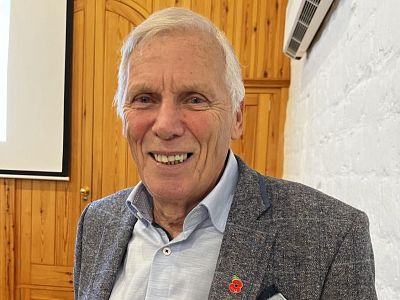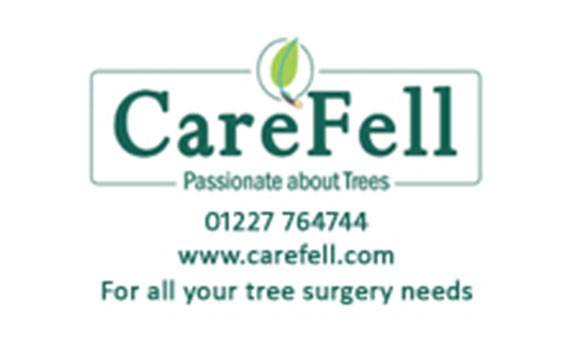Over £1K was raised for causes that we support during a recent fundraising event in which David Tadd, former head of Forensic Investigation at Scotland Yard, delivered a talk titled “Forensic Investigation: Is it fantasy, magic or a search for truth?”
David has spoken to our members before – about forensic challenges following the 2004 Tsunami. On this occasion David was talking at Kingston Village Hall to a room packed with members and guests eager to hear him speak.
After an introduction from our President Rosemary Doyle, David gave a quick overview of his career to date and his work at Scotland Yard – during which he used to be in charge of over 900 staff in the Forensic Unit. Since leaving the Yard David has continued to work as private consultant – he’s even been called in to advise on crime shows. He mentioned that TV plots didn’t always allow for the realities of forensic work ... the reason for mentioning “fantasy” in his talk title.
“Forensics,” David went on to add, is “NOT magic - but it IS magical”. To illustrate this, he showed a picture of a faint mark on skin lined up next to a ruler. A few forensic tweaks later a clear bite mark had “appeared” that could potentially identify an assailant.
During David’s talk we learned that forensics can help the criminal justice system in many, many ways. For instance, as well as identifying a criminal it can help protect the innocent (by ruling someone out from criminal suspicion), verify witness accounts, determine sequences of events, link different crimes and so on. Forensics can also be used to trap criminals.
In his two-part talk David focussed on two historical case studies: the 1981 IRA bombing campaign in London and (after we had our meal) the 1984 Brighton bomb that nearly killed then Prime Minister Margaret Thatcher.
David started with the 1981 London bombing campaign, reminding us of the various incidents that took place by showing a range of pictures from the time. (Many of us remember the news from those days and clearly recall the bombing of a Wimpy bar in Oxford Street.)
As he outlined the police’s work David praised the courageous work of explosives experts: “If they can defuse a devise that gives us lot of forensic opportunities,” he said. This can help prevent future incidents. Sadly, on this occasion, an explosives officer was killed.
At each of the London bomb scenes the forensics team had to carry out full “forensic recovery” – sometimes literally bringing in skips so that they could take the rubble off-site to be examined in detail. Overall, this was a huge investigation, with all the forensic material from the scenes having to be analysed meticulously and stored carefully.
Investigations revealed that the devices used at the various scenes had different mechanisms for detonation. This, David said, was “a very interesting fact” as “bomb makers tend to have a signature”; it led to speculation that different teams were involved in bomb making.
In 1983, some time after the bombs, forestry workers working in woods near Pangbourne in Berkshire came across two dustbins containing explosives, weapons and other equipment. “This was a major find and proved to be an Aladdin’s cave of forensic opportunities,” said David.
Investigating the find was fraught with difficulties from the outset – one of the main ones being the risk of booby traps. A forensic examination strategy was essential. Every item had to be carefully photographed, handled, logged etc. Exhibits would often be examined with relevant experts present, to ensure nothing was overlooked.
Examining the bins took several days, and David described how he would set off for work at 5am and often not return ‘til late evening. The team logged 81 exhibits in all from the two bins – each gave opportunities for fingerprinting and so on. A key find was command wire that matched wire used in one of the IRA bombs.
The fingerprints found at the scene took around nine months to analyse – the team managed to get 97 finger marks which they could compare with databases. This led to the identification of six individuals, two of whom were known bombmakers. Eventually the team was able to forensically link the found items with the various bombs, leading to several arrests (over quite a long period). David recounted having to go to court and give his evidence - quite an intimidating experience given the context of the investigation.
As David wound down the first part of his talk he picked up a nearby glass bottle. describing how the position of fingerprints can also tell investigators a lot. For instance, a certain placement of fingerprints might suggest normal use of a bottle, but a different placement would suggest the bottle was used upside down, suggesting it was used as a weapon. David also commented on how TV programmes don’t really show the huge amount of work and the large number of people, from different specialities, that would be involved in a forensic investigation: “If someone says they’re a forensic expert, always ask: in what?” he added.
At this point we had a break for a delicious meal of rice, curry and naan cooked up by Sue Thompson aided by Jane Loughran. We also held a raffle, overseen by PP Peter Hermitage, which raised around £340 for our causes.
In the second half of his talk David moved on to talk about the Brighton bombing that took place at the Conservative Party Conference in October 1984 – an investigation led by Sussex police but assisted by the Metropolitan Police.
Davd started by showing us a picture of the extensive damage to the Brighton hotel where the conference attendees had been staying. He also described the forensics scene and told us how an explosives officer was able to identify which room the bomb had been in: room 629.
The timing mechanism was found to be capable of delaying detonation for 3, 6, 12, 24 or 48 days. This meant that, using the hotel’s registration documents, the team would initially focus on identifying Room 629’s occupants during the past 48 days. One hotel registration card in particular drew their attention: a card in the name of Roy Walsh. Investigations showed no such person was living at the address given on the card. Tellingly, the dates also tallied with a detonation delay of 24 days. The card also showed an unusual print pattern that they surmised was made by the side of the suspect’s hand as he signed the card. (The team signed a number “virgin” registration cards to identify which part of the palm was involved. Nowadays police routinely take prints of the side of palms as part of the fingerprinting process.)
To make a case they would have to find 16 points in agreement between the print on the card and the suspect’s print. The investigation took place in an era before an electronic fingerprint database, which meant each print had to be manually checked against a hard copy database of known terrorists – no mean feat.
The whereabouts of the identified suspect could initially not be established by investigators. However, some 6 months after the fingerprint identification was established a small group of IRA operatives were located at an address. Police raided the address and amongst those arrested was Patrick Magee. The address revealed a significant amount of bomb making material, and documentation found indicated that a major bomb offensive was about to begin on the UK mainland. This included evidence that a bomb had already been placed in the Rubens Hotel in London, opposite Buckingham Palace. An immediate search of the hotel was carried out and a device was fortunately found and defused. The hotel registration card for the room where the bomb had been placed was retrieved and subjected to fingerprint analysis. Patrick Magee’s fingerprints were identified on the registration card.
Suspect Patrick Magee was eventually tried and found guilty in 1986. He was released in 1999 as part of Good Friday agreement.
Following a few questions from the audience David re-iterated his talk title: “Forensics certainly isn’t fantasy, it most definitely isn’t magic - it is, however, a search for the truth.”
On behalf of everyone Rosemary thanked David for “a fascinating talk” – adding how everyone present was now much enlightened about how much work goes on in the world of forensics. Rosemary also announced the fundraising total and thanked PP Neil Fraser and all others involved with the event - including Stephen Thompson and others who had sent up the tables to remind everyone of the British Legion's Poppy Appeal.
Picture: David Tadd, at our meeting the other day. Picture credit: Rotary Club of Canterbury.



